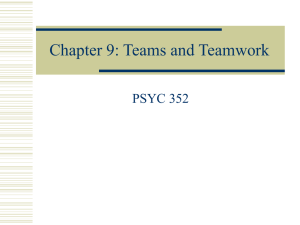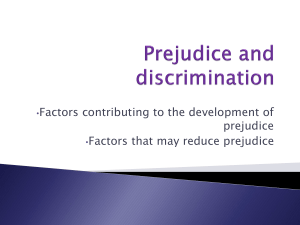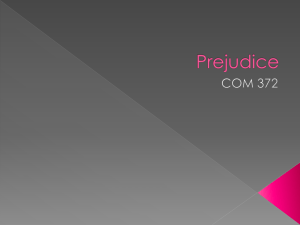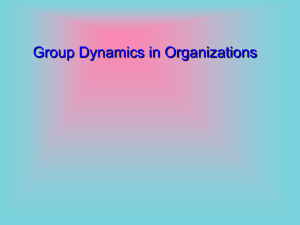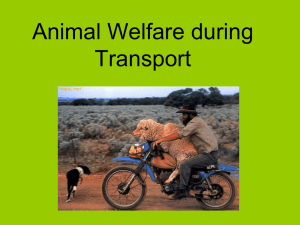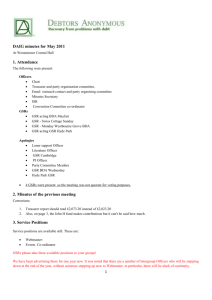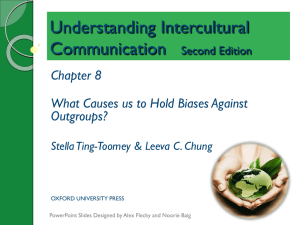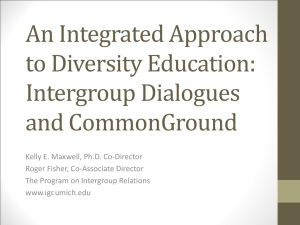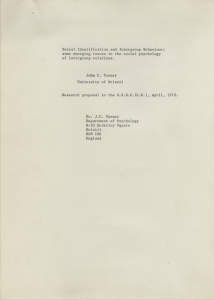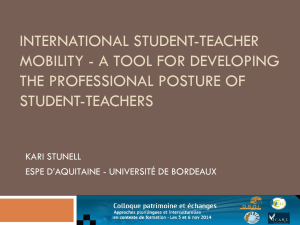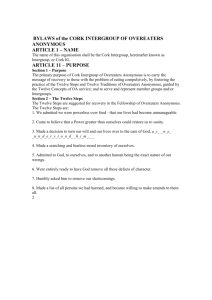Intergroup Relations
advertisement
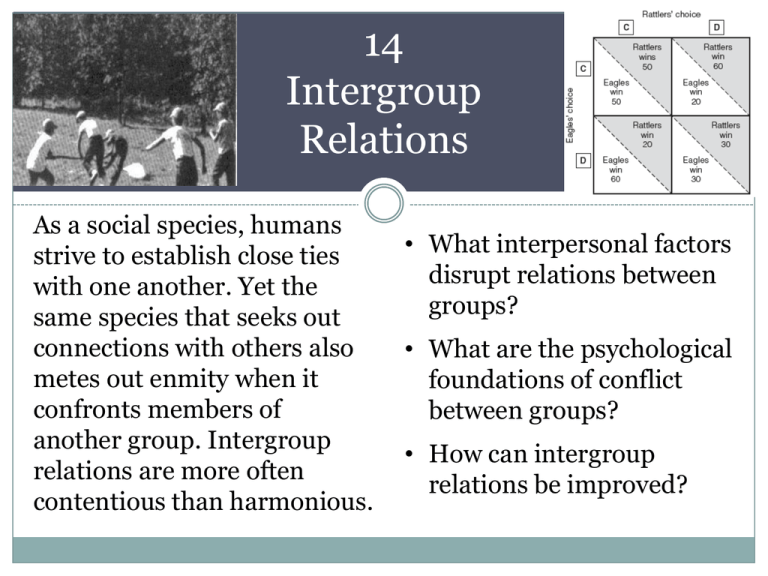
14 Intergroup Relations As a social species, humans strive to establish close ties with one another. Yet the same species that seeks out connections with others also metes out enmity when it confronts members of another group. Intergroup relations are more often contentious than harmonious. • What interpersonal factors disrupt relations between groups? • What are the psychological foundations of conflict between groups? • How can intergroup relations be improved? Causes Intergroup Bias Resolution Competition Categorization Intergroup contact Discontinuity Ingroup-outgroup bias Cognitive cures Power Cognitive biases Learning to cooperate Aggression Stereotype content model Norms Exclusion & dehumanization Evolution Categorization & identity I am, in plainer words, a bundle of prejudices— made up of likings and dislikings—the veriest thrall of sympathies, apathies, and antipathies." - Nineteenth century English author Charles Lamb I have no race prejudices, and I think I have no color prejudices nor creed prejudices. Indeed, I know it. I can stand any society.” -- Mark Twain Intergroup Relations Does membership in one group require rejection of other groups? Who does more harm? Groups or individuals? Is it hopeless? Can conflict only be reduced if all groups are blended together? Causes What Interpersonal Factors Disrupt Relations Between Groups? The Robbers Cave Experiment Conducted by Muzafer and Carolyn Sherif and colleagues in 1950s Two groups of young boys: The Rattlers and the Eagles Scenes from the Robbers Cave Causes Conflict at the Robbers Cave Competition and Conflict The Discontinuity Effect Power and Domination Intergroup Aggression Norms of Engagement Evolutionary Perspectives Result: Reactions to conflict escalated from exclusion to verbal abuse to discrimination to violence What caused the conflict between these two groups? Competition for Scarce Resources Competition Realistic Group Conflict Theory Insufficient Resources Competition for Resources Conflict Realistic group conflict theory assumes that conflict occurs because groups must compete with one another for scarce resources. Blake and Mouton documented the effects of anticipated competition on conflict. The Discontinuity Effect Insko and his colleagues find groups are more competitive than individuals People in groups are ultracompetitive Greed Identifiability Fear Diffusion of Responsibility Maier & Hinsz (2004) “Hot Sauce” Study In a purported taste test study participants (alone or in a group) were told another person or a group had sent them a cup of very, very spicy sauce to consume (48.1 grams). They then were asked to measure out a portion to send to that other individual or group. Power and Domination Economic versus militaristic (coercive) exploitation Insko’s study of laboratory microsocieties Social Dominance Theory (Sidanius & Pratto) Power: Group vs. Group If certain groups of people stayed in their place, we would have fewer problems. Sometimes other groups must be kept in their place We should do what we can to equalize conditions for groups. We should increase social equality. Spiral of negative intergroup hostility Intergroup Aggression Group A Aggression Aversive situational circumstances (pain, loss of resources, failure) Arousal paired with negative thoughts and emotions Arousal paired with negative thoughts and emotions Aversive situational circumstances (pain, loss of resources, failure) Aggression Group B The emotional mechanisms described by the frustration aggression hypothesis and the general aggression model can trigger impulsive intergroup aggression. Scapegoat Processes Intergroup Aggression Group A Aggression Aversive situational circumstances (pain, loss of resources, failure) Arousal paired with negative thoughts and emotions Group C Arousal paired with negative thoughts and emotions Aversive situational circumstances (pain, loss of resources, failure) Aggression Group B Norms of Engagement Norm of reciprocity and conflict spirals Cultural norms • Chagnon’s studies of the Yanomanö • Culture of honor Group norms (gangs, “culture of honor, etc.) Evolutionary Perspectives Violent by nature? • Hobbes: “nasty, brutish, and short” • Rousseau’s “noble savage” Cross-culture findings • Human societies tend to be violent, but Fry suggests that peaceful coexistence is a possibility. Evolutionary Psychology • Evolutionary pressures favored individuals who preferred the ingroup to the outgroup • Outgroup violence solidified the ingroup • Intergroup rejection is stronger for male members of the outgroup Causes Intergroup Bias Resolution Categorization Tajfel and Turner’s “minimal intergroup situation” Ingroup-outgroup bias • Groups were nominal, based on some trivial factor (such as art preferences) Cognitive biases • When asked to distribute resources to others, favored the members of one’s Stereotype content model own group Exclusion & They concluded (1986, p. 13): the “mere dehumanization perception of belonging to two distinct groups—that is, social categorization per Categorization & identity se—is sufficient to trigger intergroup discrimination favoring the ingroup” Ingroup-outgroup bias Ingroup Favoring the ingroup over the outgroup: Ethnocentrism Ingroup positivity tends to be stronger than outgroup negativity Double-standard thinking (and linguistic intergroup bias) Implicit intergroup biases (IAT findings) Outgroup Cognitive Biases Outgroup homogeneity bias • The perceptual tendency to assume that the members of other groups are very similar to each other, whereas the membership of one’s own group is more heterogeneous. Group attribution error • Mistakenly assuming that specific group members’ personal characteristics and preferences, including their beliefs, attitudes, and decisions, are similar to the preferences of the group to which they belong. Ultimate attribution error • Attributing negative actions performed by members of the outgroup to dispositional qualities and positive actions to situational, fluctuating circumstances. Stereotypes • A socially shared set of cognitive generalizations (e.g., beliefs, expectations) about the qualities and characteristics of the members of a particular group or social category. Stereotype content model Stereotype content model: outgroup viewed in terms of warmth and competence Emotions: Pity, contempt, envy, admiration Cuddy, Fiske, & Glick, 2007 Exclusion & dehumanization Categorization & identity Inclusion Personal Identity Achievements Need for selfesteem Group achievements Social Identity Increased self-esteem Group favoritism Outgroup rejection Not clear if outgroup rejection raises self-esteem Conflict Resolution Intergroup contact Cognitive cures Learning to cooperate Contact between the groups at the Robbers Cave did not reduce hostilities How can intergroup conflict be minimized? Intergroup contact Factors that augment the positive impact of intergroup contact Beyond the “basic” ingredients: Empirical findings • Superordinate goals (worked at Robbers Cave) • Successful cooperation • A common enemy • Online contact: The virtual contact hypothesis • Friendships: The extended contact hypothesis Intergroup contact Factors that augment the positive impact of intergroup contact Beyond the “basic” ingredients: Empirical findings • Superordinate goals (worked at Robbers Cave) • Successful cooperation • A common enemy • Friendships: The extended contact hypothesis Intergroup contact High quality contact is best, but any contact better than nothing Contact is more effective in recreational, laboratory, work and educational settings than in residential and tourist settings. Pettigrew and Tropp's review Cognitive cures Cognitive approaches to conflict reduction • Decategorization • Recategorization: The common ingroup identity model • Cross-categorization • Controlling stereotyped thinking Learning to cooperate Conflict management: interpersonal skill training procedures • Jigsaw learning groups • School-based training in conflict resolution • • • • • Define the conflict Exchange Information View from multiple perspectives Generate solutions Select mutually advantageous solution Causes Intergroup Bias Resolution Competition Categorization Intergroup contact Discontinuity Ingroup-outgroup bias Cognitive cures Power Cognitive biases Learning to cooperate Aggression Stereotype content model Norms Exclusion & dehumanization Evolution Categorization & identity Darkness cannot drive out darkness; only light can do that. Hate cannot drive out hate; only love can do that. Hate multiplies hate, violence multiplies violence, and toughness multiplies toughness in a descending spiral of destruction....The chain reaction of evil--hate begetting hate, wars producing more wars--must be broken, or we shall be plunged into the dark abyss of annihilation. Martin Luther King, Jr.
